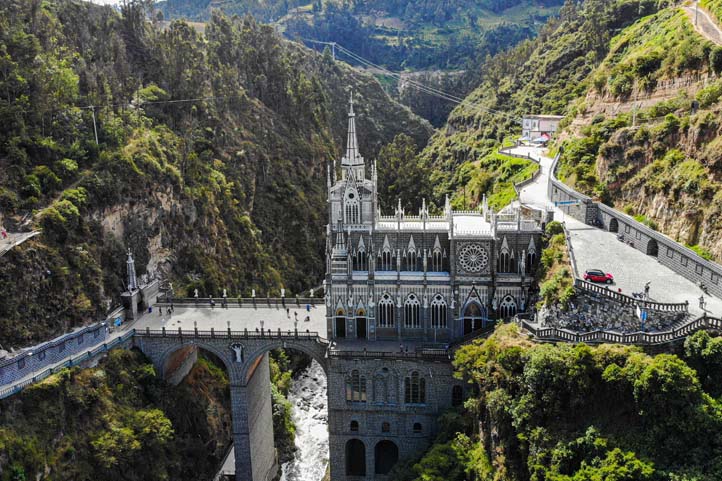Updated on 03/13/2024
Dear reader,
I would also like to recommend our Colombia travel guide, which provides a perfect overview of the tourist attractions in Colombia. Enjoy reading it!
The Spanish conquered Colombia and made it one of the most Catholic countries in the world. Indeed, Colombia is a veritable paradise for enthusiasts of colonial architecture and individuals with a deep appreciation for churches.
Content
Churches in Colombia
People practice the Catholic religion in a church. Cathedrals and basilicas are the two types of churches in Colombia.
Basilicas
Believers and ecclesiastical authorities recognize the basilica as a church. The architecture usually has more Roman and Greek attributes. There are large and small basilicas. The great basilicas, of which there are only 4 in the world, are located in the Vatican and Rome. Small basilicas are everywhere in the world. A Pope baptized each one of them.
Cathedrals
Cathedrals also symbolize the religious and administrative headquarters of a particular geographic area. In general, the architecture of a cathedral is mostly Gothic.
There are more than 70 cathedrals and around 40 basilicas in Colombia, which are spread across the different departments of the country.
Churches in and around Cundinamarca
Catedral Primada – Bogotá
![]() Centro de Bogotá (La Candelaria), Plaza de Bolívar.
Centro de Bogotá (La Candelaria), Plaza de Bolívar.
Construction: 1807-1823
Religion: Catholic
Style: Neoclassical
Height: 52 meters
Highlights: The dome
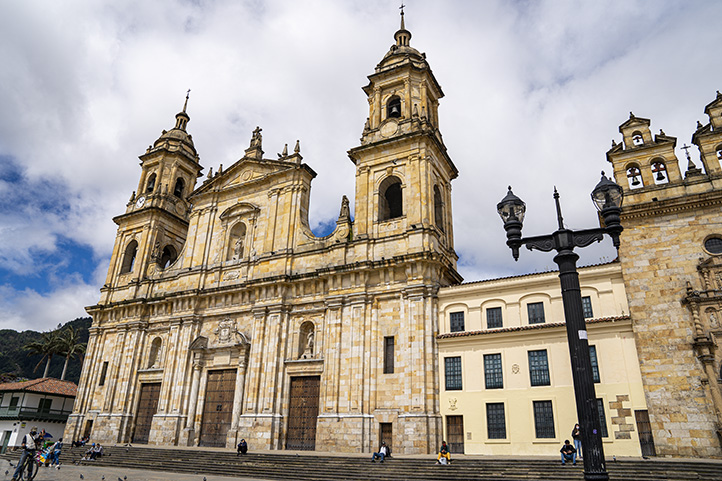
The Catedral Basílica Metropolitana de Bogotá y Primada de Colombia is a neoclassical building in Bogotá, the capital of Colombia. This Catholic Church honors the Immaculate Conception (Mary) and is a National Monument because it has preserved the columns and their gilded details, the wooden chairs, the dome, the lamps that illuminate the place, the images of saints and other details intact, although it has been rebuilt several times.
Additionally, the cathedral is part of the history of Bogotá in the Candelaria district. Furthermore, about 5 minutes from the cathedral is the Botero Museum, one of the most emblematic museums in the area.
In the immediate vicinity, there are restaurants such as “Descortés,” “Sabor antioqueño,” and “La Puerta Falsa,” the latter of which is the oldest restaurant in town, attracting both locals and visitors exploring the churches in Colombia.
Important facts
- 5 minutes walk from the Parque de los periodistas.
Iglesia Nuestra Señora de la Candelaria – Bogotá
![]() Calle 11 with Carrera 4. The church is located in the historic center of the capital, in the La Candelaria district.
Calle 11 with Carrera 4. The church is located in the historic center of the capital, in the La Candelaria district.
Construction: 1686-1703
Religion: Catholic
Style: Colonial
Highlights: Various religious paintings and stained glass windows.
The Iglesia de la Candelaria, as it is popularly known, is a Catholic church dedicated to the Virgin Mary. It is a temple of colonial origin, which consists of three rooms (naves), the central nave and two aisles, the church also has two towers on the front facade.
The church has important works of religious art inside, an example of which is the painting of the Death of St. Joseph, a painting on the ceiling of the nave. A traveler says: “This is one of the oldest churches in Bogotá, it is very beautiful and a religious and special place to get closer to God”.
The church is also located near the Catedral Primada de Bogotá.
Important facts:
- 5 minutes walk from the Parque de los periodistas.
Cerro de Monserrate, La Basílica del Señor de Monserrate – Bogotá
![]() Monserrate Hill
Monserrate Hill
Construction: 1807-1823
Religion: Catholic
Style: Neoclassical
Height: 52 meters
Highlights: Sculpture of the Fallen Lord of Monserrate
Website: https://monserrate.co/
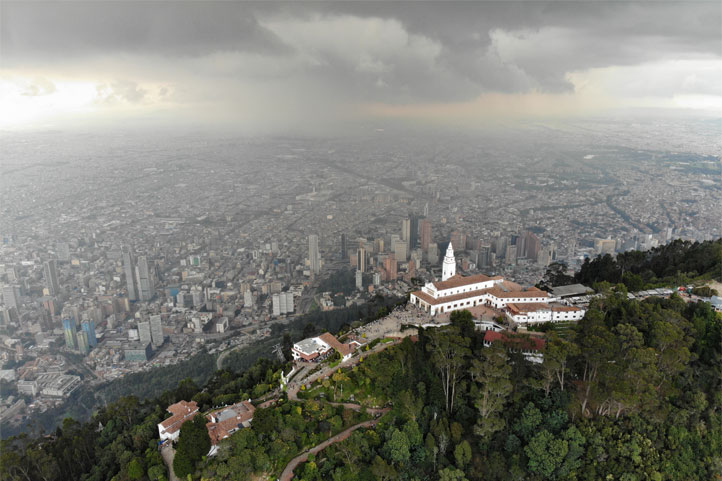
The highest point is 3,152 meters above sea level. There is a nearly three-kilometer walk from the valley station to the top. On the hill, there are also restaurants such as the Casa Santa Clara, where you can enjoy the gastronomy of the capital as well as the view. There are also around 70 species of birds, including hummingbirds and migratory birds.
Monserrate is one of the five viewpoints in Bogotá. At the top, there is also an iconic sanctuary of the city, with a history of more than 450 years. The Basilica of the Lord of Monserrate has been a religious pilgrimage site since colonial times and worships the fallen Lord of Monserrate.
There are many myths and legends about the basilica that revolve around faith, rites, and miracles. These stories also include the legend of the healing of the sick, who in return made a promise of faith. The promises people make are curious. To obtain a certain favor, men and women climb the hill on their knees or blindfolded. In addition, there are also some legends associated with this temple. It is said that fiancés who climb Monserrate will never get married.
There are 3 methods of climbing:
Funicular
Monday to Saturday between 6:30 a.m. and 12:45 p.m. (The ticket office closes at 10:00 p.m.)
Sundays between 5:30 a.m. and 5:00 p.m. (ticket office closes at 9:00 p.m.)
Holidays from 6:30 a.m. to 11:00 p.m. (after work 9:00 p.m.)
Note: remember to confirm the funicular opening times on the website.
Cable car
Monday to Saturday between 12:00 p.m. and 11:00 p.m.
Sundays from 8:30 a.m. to 4:30 p.m.
Holidays between 12:00 p.m. and 5:00 p.m.
Trail
Open to the public every day except Tuesday. Ascent open from 5 a.m. to 1 p.m., descent by 4 p.m.
Important facts:
- Distance from La Candelaria: approx. 20 minutes on foot.
- The ticket office does not accept any foreign currency
- All cards are accepted (Visa, Master, American Express, and Diners).
Santuario Virgen De Guadalupe – Bogotá
![]() Guadalupe hill
Guadalupe hill
Construction: 1945 (today’s sanctuary)
Religion: Catholic
Highlights: 15 m statue of the Virgin of the Immaculate Conception
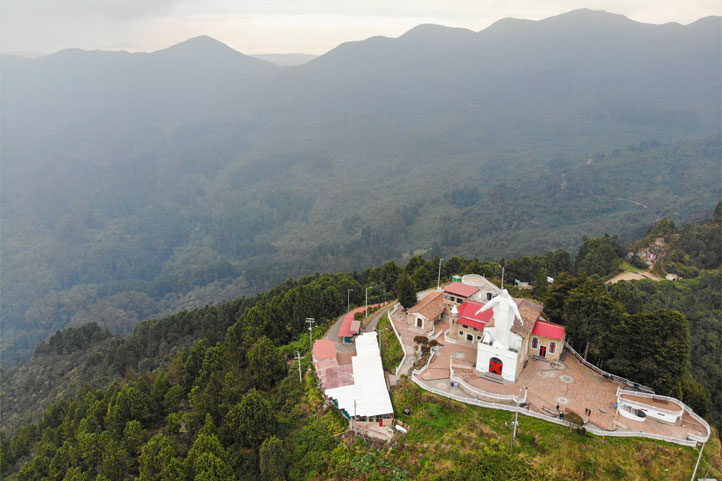
Although most of the time in Bogotá you only hear about the famous Cerro de Monserrate, there is actually another place in the capital of great historical and religious importance, namely the Cerro de Guadalupe, which is over 3,300 meters high.
The Cerro de Guadalupe is characterized by its magnificent view, from which you can see part of the capital. Apart from that, this area has had great religious importance over the centuries. More than 400 years ago, the Spanish conquistadors came here and named the place after the virgin of the same name, who is one of the patron saints of the autonomous communities of Spain. They also erected a cross to protect the capital.
The Spaniards then had a temple built, which took about 100 years to complete. Unfortunately, the sanctuary was destroyed due to earthquakes in 1743, 1785, and 1826. A newly built sanctuary was again destroyed by an earthquake in 1917. It was not until 1945 that it was decided to build the third temple (the current one), which is characterized by an imposing 15-meter-high sculpture of the Virgin of the Immaculate Conception, created by the artist and sculptor Gustavo Arcila Uribe.
Nowadays, people come to this hill to enjoy the view or to fulfill religious promises. Religious articles and handicrafts are sold in the area. There are also restaurants, although the offer is limited during the week.
Important facts
- You can easily get to the hill by car. Take the detour at kilometer 6 on the road to Choachí municipality.
Basílica del Sagrado Corazón de Jesús – Bogotá
![]() Cr 8 #40B-65, in the locality of Los Mártires
Cr 8 #40B-65, in the locality of Los Mártires
Construction: 1902-1918
Religion: Catholic
Style: Greco-Roman
Height: 55 meters
Among the many religious sites in Colombia, one of the most emblematic places that reflects the culture and history of this country is the Basilica of the Sacred Heart of Jesus.
This basilica was created in connection with the Thousand Days War, a civil war between the two (then) most important political forces in Colombia, the Liberals and the Conservatives. To end this conflict, the Archbishop of Bogota, Monsignor Bernardo Herrera Restrepo, asked the government to build what would later become the Basilica of the Sacred Heart of Jesus. All with the aim of achieving the reconciliation of all Colombians. That was in 1902.
This basilica was completed in 1918 and since the faith in the Sacred Heart of Jesus had grown greatly, this place became one of the most emblematic in the country.
Nowadays this church is a very important place of pilgrimage for Colombians and foreigners. In 1952 this was named a minor basilica by Pope Paul VI. In 1975 this religious building was declared a national monument.
Important facts
- The basilica can be reached by public transport. The following SITP buses stop nearby: 121, 60, 674, C27, G506, T12, and T25.
Iglesia del 20 de Julio – Bogotá
![]() Cl. 27 Sur #7-50, in the district of San Cristóbal
Cl. 27 Sur #7-50, in the district of San Cristóbal
Construction: 1937-1942
Religion: Catholic
Highlights: The image of the divine baby Jesus
This is another of the capital’s most traditional and iconic churches. Although the structure has beautiful architecture, where the brown facade stands out, this place is known to be the temple of the adoration of the divine child Jesus.
Construction began in 1937. In 1942, when the church was completed, an image of the divine baby Jesus was brought in. From that moment on, the July 20th Church became a place of pilgrimage for all people in Bogota. Hundreds of people visit the church every day to ask for favor with the Child Jesus.
Important facts
- The following Transmilenio routes stop nearby: L25 and L82.
Catedral de Sal – Zipaquirá
![]() The cathedral is located 29 kilometers north of Bogotá, in the city of Zipaquirá.
The cathedral is located 29 kilometers north of Bogotá, in the city of Zipaquirá.
Inauguration: 1995
Religion: Catholic
Depth: 180 meters
Highlights: The 14 Stations of the Cross
Website: https://www.catedraldesal.gov.co/
The Salt Cathedral is a space built inside the Zipaquirá Salt Mines. It is an architectural jewel of the modern age because the underground church is part of the famous “Parque de la Sal” (salt park), which offers a variety of activities. The Salt Cathedral was chosen by the Colombians as one of the 7 wonders of the world of Colombia.
Inside the mine, you can enjoy a breathtaking tour. Along the way, you can visit the stations of the cross. There are 14 points on which there are different crosses that represent the suffering of Jesus, his death, and later his resurrection. Various tourist activities are also offered.
There is a room with a light show, a water mirror and for the youngest and most curious it is possible to explore the Miner’s Route, where you can visit some geological formations in the mine.
Important facts
- The tour takes about 90 minutes
- Cost per person from Bogota: $ 300,000 COP (private transport)
Learn more about this and other wonders of the country in my blog about the 7 wonders of Colombia.
Boyacá churches
Nuestra Señora del Rosario – Villa de Leyva
![]() East side of the Plaza Mayor from Villa de Leyva.
East side of the Plaza Mayor from Villa de Leyva.
Construction: 1604-1608 approximately
Religion: Catholic
Style: Colonial Baroque
Highlights: Colonial paintings by famous artists of the time, such as Gregorio Vásquez de Arce y Ceballos.
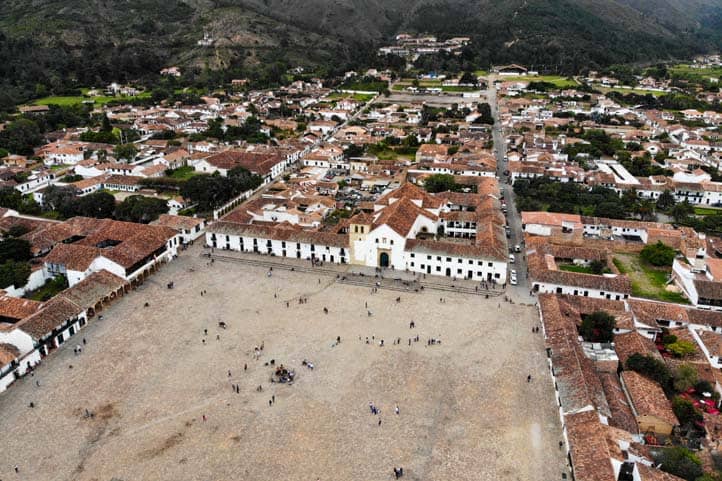
The construction of this church began around 1608, by order of the Spanish king at the time. Ever since, it has been known as “The Cathedral,” and its tower carries the distinct characteristics of Castilian architecture.
Undoubtedly, one of the most striking elements is the colonial architecture, which effectively preserves a snapshot of Colombian history. Presently, the parish church boasts a structure adorned with white-painted stone, and its interior beautifully showcases the features of the colonial era. The altars, pictures, and representations within exude a captivating Baroque style.
What sets the parish church apart is its role as a witness to significant historical events. It was within its walls that Captain Antonio Clemente, renowned as the Hero of San Mateo for his involvement in rebelling against the colonial regime, was baptized. Additionally, General Antonio Amador José de Nariño, a notable Colombian politician and military figure, found his final resting place there. For the sake of his safety, his remains were later relocated.
Villa de Leyva is a popular tourist destination frequently visited by locals from Bogota and Boyaca on weekends and holidays. To make the most of your visit, it is advisable to plan it during the week.
Important facts
- Distance from Tunja: 1 hour
- Cost per person by bus from Tunja: approx. $ 25,000 COP
Iglesia Nuestra Señora del Carmen – Villa de Leyva
![]() The church is located one block from Villa de Leyva’s main square.
The church is located one block from Villa de Leyva’s main square.
Construction: 1850
Religion: Catholic
Highlights: The Image of the Virgen Renovada (Renewed Virgin)
Nuestra Señora del Carmen Church is a monastery church not to be missed when visiting Villa de Leyva. The church was consecrated in 1850 and is characterized by its colonial style and beautiful white facade.
If you are a fan of the Virgen del Carmen, you should definitely visit this church, because one of the two chapels is dedicated to the Holy Mother. In the second chapel, affectionately called Mamá Linda by the villagers, is the image of the Virgen Renovada (Renewed Virgin). This image is considered an icon and is revered in the region.
Another highlight of this church is the Museo del Carmen de Arte Religioso (Museum of Religious Art). This attraction was founded in 1971 by a Carmelite monk named Rafael Eugenio Mejia. The museum has 6 halls in which more than 100 articles and works of art of religious character from the 17th century are exhibited. Some of these objects were brought directly from Europe.
Important facts
- The museum is open from Friday to Sunday from 9:00 a.m. to 5:00 p.m.
Basílica Menor de Nuestra Señora de Monguí – Monguí
![]() Cra. 3 #42
Cra. 3 #42
Construction: 1694-1760
Religion: Catholic
Style: Romanesque
Height: 63 meters
Highlights: Image of Our Lady of Monguí.
Monguí and Villa de Leyva are the only heritage towns in Boyacá. The Basílica Menor de Nuestra Señora de Monguí is without a doubt the most important religious building in the listed city. This imposing structure was built in stone and has beautiful Romanesque architecture.
The church was built between 1694 and 1760 and was of historical importance even during the Spanish colony. This place was originally a teaching chapel used by the Franciscan order to evangelize the indigenous people in the Boyacá region.
For those interested in religious art, there are many paintings inside the basilica. One of the outstanding works is the painting of Our Lady of Monguí, which shows the Holy Mother with a little Jesus in her arms. There are other paintings by anonymous authors depicting various scenes from the biblical story. The basilica was restored in 2016 with the aim of preserving and caring for this historic place. As one explores the churches in Colombia, the Basílica Menor de Nuestra Señora de Monguí remains a captivating testament to the region’s cultural and religious heritage.
Important facts
- Monguí is located around 225 kilometers from Bogotá. The journey takes around 3 hours and 30 minutes.
- Next to the site is the Real Calicanto Colonial Bridge, which is one of the most iconic landmarks in the community.
Churches in Antioquia
Catedral Basílica Metropolitana de Medellín – Medellín
![]() Cr 56 #48-26
Cr 56 #48-26
Construction: 1890-1931
Religion: Catholic
Height: 66 meters
This cathedral is one of the largest and most majestic buildings in Medellín. It has a symmetrical structure with two huge towers, each measuring 66 meters. The construction required around 1,120,000 bricks. It became a national monument in 1982. Additionally, Medellín is renowned for its beautiful churches, and this cathedral stands as a testament to the rich religious heritage found in churches in Colombia.
Construction began in 1890 and in 1948 Pope Pius XII awarded this religious building the title of a minor basilica. There are several religious paintings inside the basilica. There are also interesting sights such as the Museum of Religious Art, which exhibits around 40 sculptures from the 17th, 18th, and 19th centuries. Unfortunately, the museum is not open to the public.
Important facts
- The cathedral is located in the central area of Medellín, on the north side of Bolívar Park.
- Photography is only allowed without the flash.
- The area around the church is popular with pickpockets.
Churches in Santander
Basílica Menor San Juan Bautista – Girón
![]() Cl 30 #26-54
Cl 30 #26-54
Religion: Catholic
Highlights: The image of the Lord of Miracles.
About 5.5 miles (9 km) from the city of Bucaramanga is another of the 17 Colombian cultural heritage towns. This beautiful town is characterized by its cobblestone streets and colonial architecture, including several churches in Colombia. The Colombian heritage cities are characterized by their centuries-old buildings. One of the most beautiful and historic buildings in Girón is the Basílica Menor San Juan Bautista.
Construction of the church began in 1636. It has a white facade, a symmetrical structure, and two imposing towers. In addition, the church is surrounded by a large number of buildings with colonial architecture. In 1998 the church was declared a basilica.
Inside is one of the greatest icons of religious culture in Colombia, the image of the Señor de Los Milagros (Lord of Miracles). This figure is the reason why many locals and tourists visit this place. Miraculous powers are ascribed to the image. People from all over the world visit the Señor de los Milagros to say thank you for a favor (mostly related to health) or to ask something about this heavenly figure.
The best time to visit this place is September 14th. The feast of Señor de los Milagros is celebrated on this date. During this festival, you can pay homage to the religious figure and enjoy fireworks.
Important facts
- Giron is just a 20-minute drive from Bucaramanga.
Churches in Bolívar and Atlántico
San Pedro Claver – Cartagena
![]() Corner of Calle 31 and Carrera 4, right in front of Plaza de la Aduana, in the historic center of Cartagena.
Corner of Calle 31 and Carrera 4, right in front of Plaza de la Aduana, in the historic center of Cartagena.
Construction: 1580 – 1654
Religion: Catholic
Style: Baroque
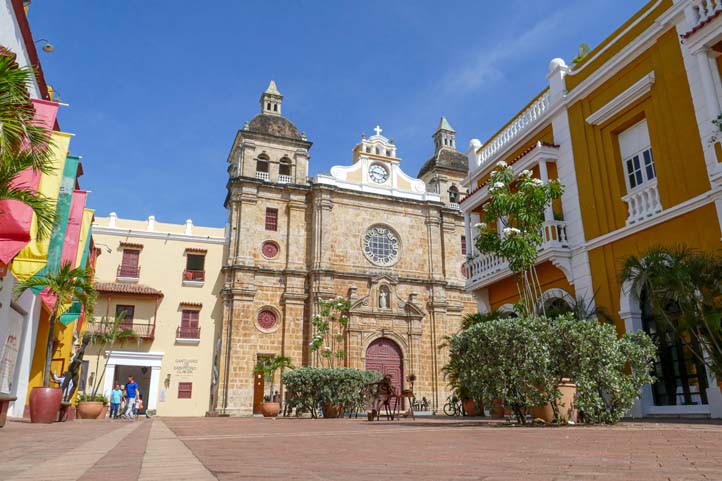
The church is a Colombian Catholic Church dedicated to Saint Peter Claver. This saint was a Spanish Jesuit missionary and priest who gained recognition for his dedication to alleviating the suffering of slaves.
It is one of the many churches in Colombia that holds a prominent position as one of the country’s most significant architectural marvels and has earned the prestigious designation of being a national monument. Moreover, it enjoys immense popularity as a preferred venue for weddings in Cartagena due to its historical significance and captivating charm.
Situated within the historic area of Cartagena, the church offers a splendid opportunity to immerse oneself in the city’s rich history. The surrounding area, exemplified by the Plaza de la Aduana, serves as a testament to the colonial architecture prevalent in administrative buildings of that era. Notably, you can also discover the dwelling where Pedro de Heredia, the founder of Cartagena, once resided, as well as a monument paying tribute to Christopher Columbus
Catedral Metropolitana María Reina – Barranquilla
![]() In the center of Barranquilla, on the western side of the Plaza de la Paz.
In the center of Barranquilla, on the western side of the Plaza de la Paz.
Construction: 1955 – 1982
Religion: Catholic
Style: Modern
Height: 38 meters
Highlights: 16-meter high sculpture of the Latin American Christ the Liberator
This cathedral, one of the remarkable churches in Colombia, is dedicated to the veneration of the Blessed Virgin Mary. It is an imposing modernist-style building, construction of which began in 1955 and lasted 27 years. Nowadays it is the most representative church in Barranquilla.
One reason to visit this cathedral is the imposing sculpture of the Latin American Liberator Christ, which is 16 meters high and 7 meters wide, weighs 16 tons, and is made of bronze.
There are also two large mosaics inside the cathedral. On the right side of the entrance is St. Joseph, the patron saint. On the left is the Queen Mary, the patron saint of the Metropolitan Cathedral. These mosaics are a total of 16 meters high and five meters wide, each of the figures is nine meters high.
According to one visitor, upon arrival one becomes “aware of the immensity of God and how tiny man is in the face of this greatness”.
San Nicolás de Tolentino – Barranquilla
![]() Historic center of Barranquilla, presiding over the San Nicolas square, on the eastern side of the Bolivar promenade.
Historic center of Barranquilla, presiding over the San Nicolas square, on the eastern side of the Bolivar promenade.
Construction: 1734-1907
Religion: Catholic
Style: Neo-Gothic
Highlights: Relics of San Nicolás de Tolentino
The Colombian Ministry of Culture declared the Church of San Nicolás de Tolentino, one of the prominent churches in Colombia, a cultural asset of national character in 2005. According to its history, this church took 300 years to build. It has been open to the public again since 2011 and is captivating today with its dazzling Gothic facade.
This church is a Roman Catholic church that honors Saint Nicholas of Tolentino, who is known as “the advocate of blessed souls”. Inside, it has “a small cloth” as an authentic relic. The cloth is soaked with the blood of the saint’s (Nicholas) incorruptible body and people venerate it on feast days.
The Church of San Nicolás is located on the famous square of the same name. The San Nicolás square is the setting for the work “Memoria de mis putas tristes” by the famous Colombian artist Gabriel García Márquez.
Churches in Magdalena
Catedral Basílica del Sagrario y San Miguel de Santa Marta – Santa Marta
![]() La Catedral Square
La Catedral Square
Construction: 1734-1907
Religion: Catholic
Style: Renaissance
Highlights: Tomb of Santa Marta’s founder
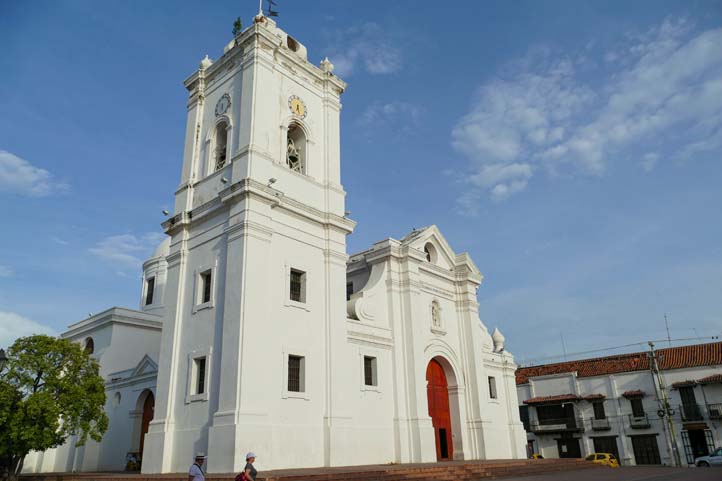
With a beautiful white facade and a Romanesque Renaissance architectural style, we find one of the most important religious structures in Santa Marta, among the many churches in Colombia.
Builders started the construction of this cathedral in 1766 and it has a huge and imposing tower with a bell tower. Inside the structure, we can see various interesting sights, for example, the tomb and monument of Don Rodrigo de Bastidas, who founded Santa Marta.
The Cathedral Basilica is also known for housing the remains of Simón Bolívar. He is considered the liberator of several Latin American nations. The body was here from 1830 to 1842 and was then transferred to its birthplace, Venezuela.
Churches of the Valle del Cauca
Basílica Menor del Señor de los Milagros – Buga
![]() Historic center in Guadalajara de Buga, in the Valle del Cauca department.
Historic center in Guadalajara de Buga, in the Valle del Cauca department.
Construction: 1892 to 1907
Religion: Catholic
Highlights: Image of the Señor de Los Milagros de Buga (Lord of the Miracles of Buga)
Renowned as the foremost tourist attraction in Buga city, this church possesses an emblematic and charismatic presence. The compact basilica stands proudly, measuring 33 meters in height and stretching an impressive 80 meters in length. A notable feature is the inclusion of a French clock seamlessly integrated into its structure.
Stepping inside one of the churches in Colombia, such as this, one is greeted by the captivating image of the Lord of Miracles. This dark-colored sculpture, crafted from cast iron, depicts the lifeless body of Christ, his form contorted, hair drenched in blood, and lips slightly parted. Legend tells of a fateful incident when a visitor attempted to burn the image. Astonishingly, the figure began to exude perspiration, as the flames failed to leave any mark. In fact, it was said that the sculpture emerged even more resplendent after enduring the trial by fire. Naturally, the belief in the miraculous nature of this sculpture grew exponentially among the local populace.
Over time, a multitude of believers, both local and foreign, embarked on pilgrimages to this sacred site. They arrived to express gratitude, offer prayers, and engage in deep contemplation. Many sought solace in the presence of the Lord, beseeching miracles and laying their special requests at his feet. As one traveler eloquently described, “Upon entering the temple, an overwhelming sense of serenity envelops you, infusing you with strength, compelling you to linger. The space is imbued with an energy that is profoundly rare to encounter.”
Important facts
- The journey time from Cali is around 90 minutes.
Iglesia de la Ermita – Cali
![]() Simon Bolivar Park in Cali
Simon Bolivar Park in Cali
Construction: 1930 to 1948
Religion: Catholic
Style: Gothic
Highlights: Image of the Virgen de los Dolores and the Señor de la Caña (Lord of the Cane)
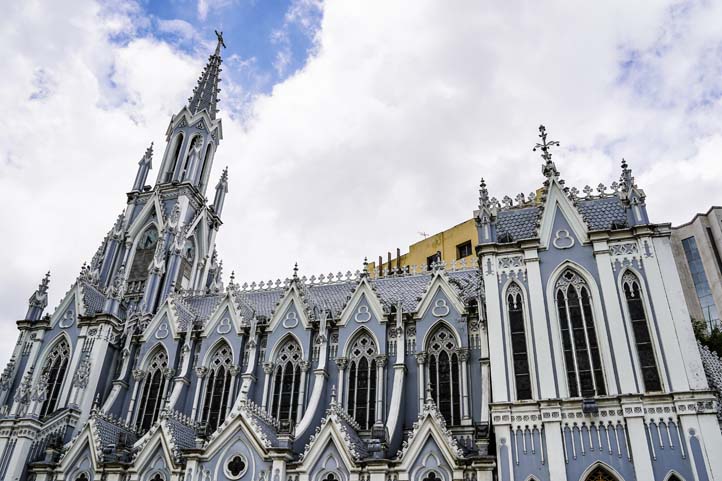
Located within the districts of El Hoyo and El Calvario in Cali, the church of La Ermita captivates visitors with its distinctive Gothic style, much like many other stunning churches in Colombia. However, what stands now is a scaled-down replica of the original church, which unfortunately succumbed to the forces of an earthquake.
The Ermita boasts a collection of revered images, including the Virgen de los Dolores (Virgin of Sorrows) and the Señor de la Caña (Lord of the Cane). Its construction took place between 1930 and 1948, and the mesmerizing marble altar, sourced from Italy, never fails to leave a lasting impression on all who visit. Therefore, it proudly stands as one of the iconic landmarks adorning the architectural landscape of Cali city.
Churches of Nariño
Santuario de Las Lajas – Ipiales
![]() Simon Bolivar Park located in the municipality of Chinchiná (11 miles/18 km from Manizales).
Simon Bolivar Park located in the municipality of Chinchiná (11 miles/18 km from Manizales).
Construction: 1916 to 1949
Religion: Catholic
Style: Neo-Gothic
Highlights: Image of the Virgin Mary of the Rosary from Las Lajas
This church is a large construction on a cliff. It is a temple and a basilica made of gray and white stone. What makes it unique is that it is decorated with a crown made of gold, sapphires, diamonds, pearls, and emeralds.
The Santuario de las Lajas is a very popular church among Catholics and Christians because its architecture and appearance have turned this place into a fairy tale. Many pilgrims visit the church, making it one of the most enchanting churches in Colombia.
According to the story, a woman and her deaf-mute daughter were walking through the gorge of the Guáitara River when they suddenly saw the image of the Virgin Mary amid the rain and rocks. People say that the daughter regained her voice and hearing at that very moment. This is one of the miracles that the Virgin performed.
Important facts
- The sanctuary is on the border with Tulcán, Ecuador.
- We offer more information on our blog about Las Lajas.
Churches of Caldas
Basílica de Nuestra Señora de las Mercedes – Chinchiná
![]() Simon Bolivar Park located in the municipality of Chinchiná (11 miles/18 km from Manizales).
Simon Bolivar Park located in the municipality of Chinchiná (11 miles/18 km from Manizales).
Construction: Inaugurated in 1934
Religion: Catholic
Style: Neo-Gothic
Highlights: Image of the fallen lord
Located in Chinchiná, this Catholic temple is a French Gothic-style basilica that has been on the register since 1934. The people of Chinchiná take pride in it and consider it an architectural jewel, since Pope Benedict XVI raised it to the rank of a minor basilica on September 24, 2009, and he consecrated it on November 30 of the same year. This basilica is one of the many stunning churches in Colombia.
When visiting the basilica, believers can take part in the sacred rites or recite the Sunday prayer (Our Father), the Ave Maria, and the symbol of faith (Creed). Another attraction of the church is the beautiful stained glass windows that adorn the walls of the church. These colorful works tell part of the biblical story, such as the death of Christ.
Important facts
- The journey time from Manizales is around 50 minutes
Catedral-Basílica Metropolitana Nuestra Señora del Rosario – Manizales
![]() Plaza de Bolívar
Plaza de Bolívar
Construction: 1928-1939
Religion: Catholic
Style: Neo-Gothic
Height: 115 meters
Highlights: Canopy with 64 images of saints and decorative glass windows

Today’s Manizales Cathedral is the result of an international competition that was held after three fires struck the city in 1922. The construction lasted for 11 years and used imported materials.
As a result, at a height of 115 meters from the foot of the temple, it is now the tallest cathedral in Colombia and can accommodate 5,000 people. Builders used reinforced concrete to build the Metropolitan Cathedral, which has mostly Gothic architecture elements, but also some Byzantine and Roman details.
One of the attractions of the church is the rose window, which is located above the main gate. Mario de Ayala made these to commemorate the Virgin of the Rosary in Cali. The cathedral’s huge stained glass windows, which show works by French, Italian and Colombian artists, are another attraction.
Two of the main stained glass windows in the cathedral are as follows:
- Stained glass window of the Last Supper: It depicts the Lord’s Supper that Jesus and the twelve disciples kept.
- Stained glass of Abraham and Melchizedek: It depicts Abraham at the moment of the sacrifice of his son Isaac; Melchizedek also appears and offers bread and wine.
The Manizales Cathedral is a significant religious and cultural landmark, showcasing the rich history and craftsmanship found in the churches of Colombia.
The most important sacred dates in Colombia
Holy Week or Semana Mayor is the most important religious holiday for Catholics, not only in Colombia but also in other countries on the American continent. This week represents a time of reflection and prayer celebrated every year in Colombia between March and April.
During these eight days, believers interrupt their usual activities, take part in celebrations, processions, masses, and fasts, and practice abstinence to commemorate the suffering, death, and resurrection of Jesus Christ. In Colombia, this sacred observance is enriched by the presence of numerous churches throughout the country. These churches in Colombia serve as sacred spaces where Catholics gather to engage in prayer, worship, and reflection during Holy Week. The architectural beauty and historical significance of these churches further enhance the religious experience for the faithful.
For Catholics, each of these days has a special meaning:
- Palm Sunday = beginning of the week and commemoration of the arrival of Jesus in Jerusalem.
- Easter Monday = worship of God in the churches.
- Good Friday = the announcement of the death of Jesus.
- Holy Wednesday = the planning of the betrayal of Jesus.
- Holy Thursday = the last supper.
- Good Friday = the crucifixion and death of Jesus.
- Holy Saturday = Easter Vigil.
- Easter Sunday = the end of Holy Week with the resurrection of Christ.
This week we are reminded that Colombia is considered one of the most Catholic countries in the world (despite freedom of religion).
This is undoubtedly a time of faith and meditation for the believer, but it is also a week of culture and spectacle. Find out more about this festival in my blog Semana Santa in Popayán.
Colombia Travel Tips
- Colombia Travel Medical Advice & Vaccination Details
- 29 Travel Tips You Need To Know Before Coming To Colombia
- 99 Facts & Information About Colombia You Should Know
- Colombia Weather Guide for Travelers
More Destinations in Colombia
- 99 Must-See Destinations that Will Make You Fall in Love with Colombia
- Colombia’s Top 23 Largest and most Important Cities – Key Data and Insights
- 7 Wonders of Colombia Complete Guide
- Colombia’s Top 117 Museums: A Cultural Traveler’s Comprehensive Journey
- 21 Spectacular Churches in Colombia
- What Are The Best Luxury Destinations In Colombia?
- Sample Luxury Travel Itinerary in Colombia
- Instagram Colombia – The 17 Most Beautiful Places for Photos

